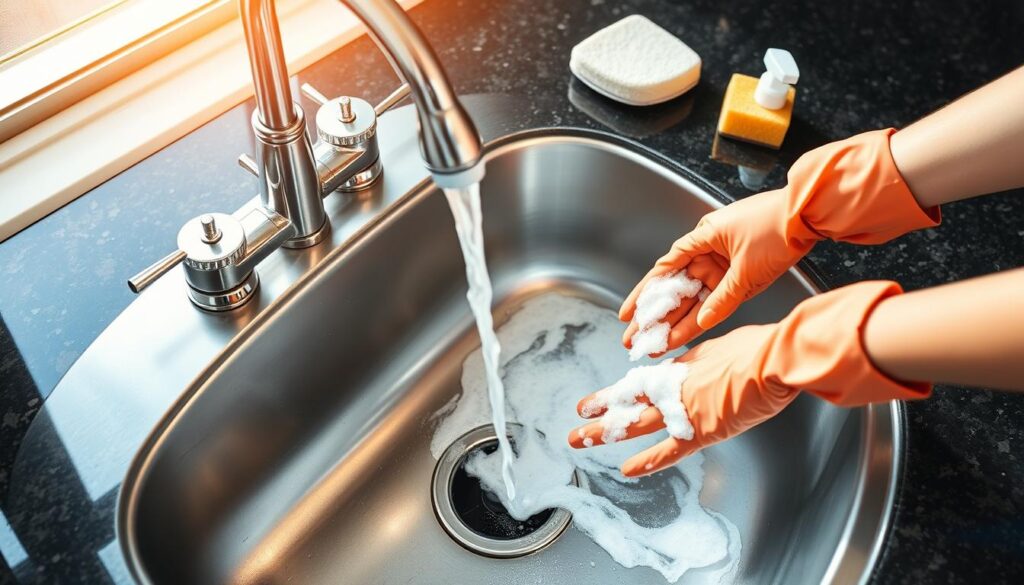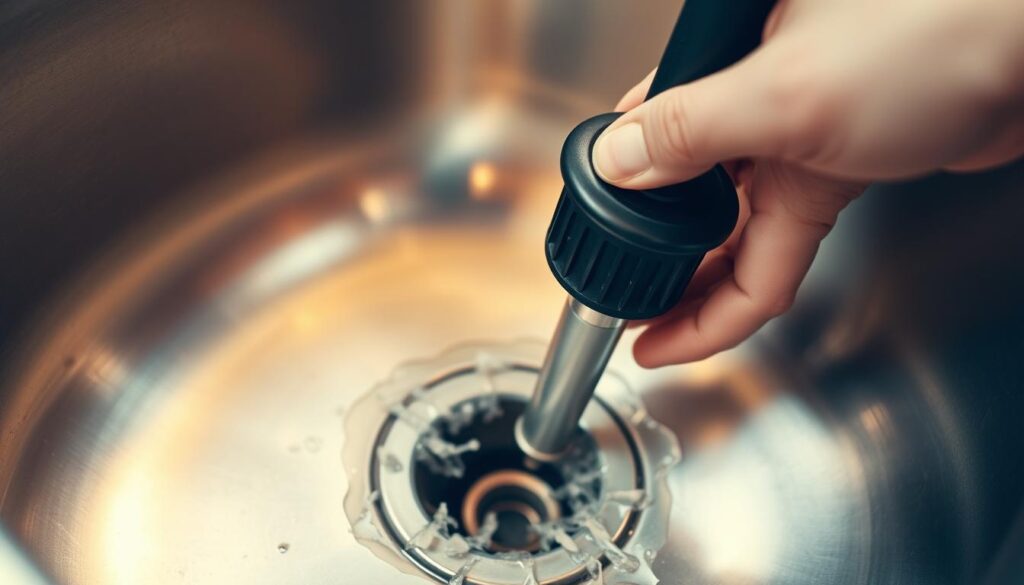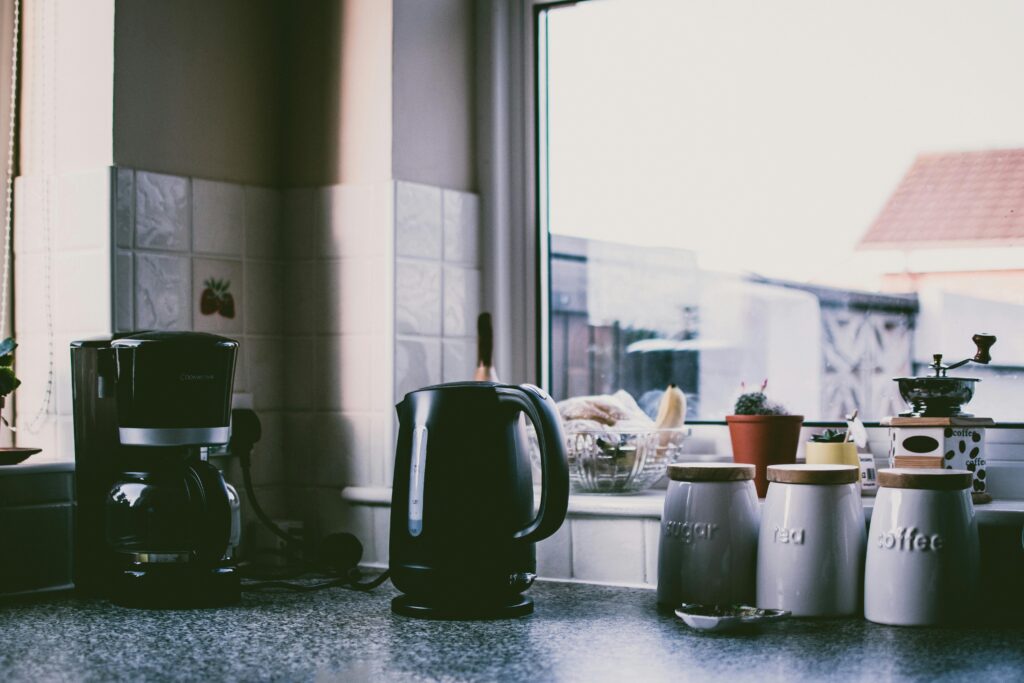I’m excited to share my personal experience and tips on kitchen sink cleaning and drain maintenance. As a homeowner, I’ve learned the importance of regular sink care. It keeps my kitchen clean, hygienic, and working well.
Regular kitchen sink cleaning is key for a healthy and clean space. By following my tips, you can tackle tough stains, prevent clogs, and make your sink last longer. In this article, I’ll share all you need to know about cleaning your kitchen sink, maintaining your drain, and caring for your sink.

From my experience, regular cleaning and maintenance greatly improve your kitchen sink and drain’s look and function. By focusing on kitchen sink cleaning and drain maintenance, you can keep your kitchen clean and healthy.
Introduction to Kitchen Sink Cleaning
In the following sections, I’ll explore the importance of regular cleaning. I’ll also share the best ways to deal with tough stains and clogs. Plus, I’ll give you tips on sink care and drain maintenance.
Key Takeaways
- Regular kitchen sink cleaning is essential for maintaining a healthy environment
- Drain maintenance is key for preventing clogs and extending sink lifespan
- Proper sink care greatly improves your kitchen sink’s look and function
- Kitchen sink cleaning and drain maintenance can be easy and effective with the right tips and methods
- Regular cleaning and maintenance can help prevent tough stains and clogs
Why Regular Kitchen Sink Cleaning Matters
Regular kitchen sink cleaning is key to a healthy kitchen. It stops bacteria and germs from building up. This helps keep you and your family safe from illness.
Regular sink maintenance has many benefits:
- It stops drain clogs, saving you money and time.
- It makes your sink last longer, avoiding expensive fixes.
- It keeps your kitchen clean and safe, lowering illness risks.
By focusing on kitchen sink cleaning and sink maintenance, your kitchen stays clean and functional. This prevents many issues, like clogs and illness spread.
Putting kitchen hygiene first makes your kitchen healthier for everyone. Regular sink maintenance is easy and effective. It helps avoid many problems in the future.
Essential Tools and Supplies I Use
To keep my kitchen sink and drain clean, I use a few key tools. I have a soft sponge or cloth, a gentle cleaning solution, a scrub brush, and a drain snake. I also use a microfiber cloth to dry the sink and stop water spots, which is key for sink care.
I choose natural and gentle products for kitchen cleaning tools. Baking soda, vinegar, and lemon juice are great for removing stains and odors. Having the right tools makes cleaning easier and more effective.
Some of the main tools I use for sink care include:
- A soft sponge or cloth for wiping down the sink
- A gentle cleaning solution for removing stains and odors
- A scrub brush for tackling tough stains and grime
- A drain snake for clearing clogs and blockages
- A microfiber cloth for drying the sink and preventing water spots
Using these essential tools and supplies helps me keep my kitchen sink and drain clean. Regular sink care and maintenance prevent clogs and blockages. It also reduces the need for harsh cleaning solutions.
My Pre-Cleaning Sink Preparation Steps
Before I start cleaning my kitchen sink, I prepare it well. This ensures a thorough and safe cleaning. I remove any dishes or food debris to avoid clogs and make cleaning easier.
I also rinse the sink with warm water to remove loose particles. This helps loosen tough stains. I use a soft sponge or cloth to avoid scratching the sink.
While preparing the sink, I also focus on safety. I wear gloves and work in a well-ventilated area. This prevents exposure to harsh chemicals and keeps the cleaning environment healthy.
Removing Dishes and Food Debris
- Remove any dishes, pots, and pans from the sink
- Scrape off any food debris from the dishes and sink surface
- Rinse the sink with warm water to remove any loose particles
Initial Rinse Process
After removing dishes and debris, I rinse the sink with warm water. This loosens tough stains and makes cleaning easier.
Safety Precautions
I always take safety precautions during cleaning. I wear gloves and work in a well-ventilated area. This prevents exposure to harsh chemicals and keeps the environment healthy.
Cleaning Your Kitchen Sink and Drain: My Method
For kitchen sink cleaning, I mix gentle solutions with effective cleaning methods. I start by applying a mild cleaner to the sink. It sits for a few minutes to loosen tough stains or grime. This is key for drain cleaning too, as it breaks down clogs.
Next, I scrub the sink with a soft sponge or cloth. I move in circles to remove stains or debris. This method prevents scratches and ensures a deep clean. After, I rinse with warm water to get rid of any leftover solution or debris.
Some important cleaning methods I use are:
- Using a gentle cleaning solution made for kitchen sink cleaning
- Letting the solution sit for a few minutes for effective drain cleaning
- Scrubbing the sink with a soft sponge or cloth to avoid damage
- Rinsing with warm water to remove any remaining solution or debris
By following these steps and using the right cleaning methods
Deep Cleaning the Sink Basin
Deep cleaning the sink basin is key to a clean kitchen. Start with natural cleaning solutions like baking soda and vinegar. They are great for sink basin cleaning because they remove tough stains and grime.
To get rid of tough stains, I use a soft scrub brush and some effort. It takes time, but it’s worth it for a clean sink. For a shiny finish, I buff with a microfiber cloth.
- Using a mixture of equal parts water and white vinegar to remove mineral deposits
- Applying a paste made from baking soda and water to remove tough stains
- Utilizing natural cleaning solutions such as lemon juice and borax to sanitize and deodorize the sink basin
By using these methods, you can keep your sink basin clean and hygienic. Regular sink basin cleaning and polishing techniques prevent grime and stains. This makes cleaning easier and more efficient.
Dealing With Stubborn Drain Clogs
When it comes to drain clogs, prevention is key. But sometimes, clogs can happen. To tackle stubborn drain clogs, I suggest using a mix of plumbing tips and tools. Start by trying a drain snake or plumber’s auger to clear out blockages or debris.
If the clog is really tough, I might use baking soda and vinegar. This combo is great for clog removal and is also eco-friendly. Here are some more tips for dealing with stubborn drain clogs:
- Use a plunger to create suction and help loosen the clog
- Pour hot water down the drain to help dissolve any grease or debris
- Use a natural cleaning product to help break down any tough blockages
By following these plumbing tips and using the right tools, you can tackle even the toughest drain clogs. Always be gentle when trying to remove a clog. You don’t want to damage your pipes or plumbing system. If you’re unsure or if the clog doesn’t go away, it’s best to call a professional plumber for help.

Maintaining a Fresh-Smelling Drain
To keep my kitchen sink and drain smelling fresh, I focus on drain maintenance. I use natural deodorizers like lemon juice or essential oils. This keeps my kitchen healthy and clean.
Running hot water through the drain is part of my weekly maintenance. It helps keep the drain flowing and prevents clogs. I also use a drain cleaner when needed. Plus, natural deodorizers work well without harsh chemicals.
- Using baking soda and vinegar to absorb and eliminate odors
- Running lemon juice or essential oils through the drain to leave a fresh scent
- Utilizing a drain screen to catch hair and other debris before they go down the drain
By doing these simple tasks, my drain stays fresh and my kitchen is healthy. Regular drain maintenance prevents clogs and keeps my sink and drain in good shape.
Special Care for Different Sink Materials
Keeping your kitchen sink in top shape is key. It’s important to know the right care for your sink’s material. I’ve found that understanding your sink’s needs makes a big difference in keeping it clean and hygienic.
Stainless steel care means using gentle cleaners and soft scrubbers. This prevents scratches. For porcelain sink maintenance, a soft sponge and mild cleaners are best. Knowing your sink’s specific needs helps it last longer.
- Use a gentle cleaning solution for stainless steel sinks
- Avoid harsh chemicals or cleaners for porcelain sinks
- Use a soft sponge or cloth for composite sinks
By following these tips, you can keep your sink looking great. It will stay a clean and useful space for cooking.
My Weekly Maintenance Schedule
To keep my kitchen sink and drain in top shape, I stick to a weekly maintenance plan. I clean the sink and drain with a soft cleaner, then rinse with warm water. After that, I dry it with a microfiber cloth. I find that a regular cleaning schedule stops dirt and grime from building up.
In my weekly maintenance routine, I also run hot water through the drain. Sometimes, I use a drain cleaner to keep the drain clear. This keeps my sink and drain working well and saves me from expensive fixes.
Some important tasks for your sink maintenance routine are:
- Cleaning the sink and drain with a gentle cleaning solution
- Rinsing the sink with warm water
- Drying the sink with a microfiber cloth
- Running hot water through the drain to prevent clogs
By sticking to a regular cleaning schedule and doing these simple tasks, you can keep your kitchen sink and drain in great shape. Always use gentle cleaners and avoid harsh chemicals that can harm your sink and drain.

Eco-Friendly Cleaning Solutions I Recommend
I’ve been looking for ways to keep my kitchen sink and drain clean. I found that using eco-friendly cleaning solutions is key. These options are better for the environment and safer than harsh chemicals. I’ve learned that natural cleaners like baking soda, vinegar, and lemon juice work well.
These natural cleaners are good for the planet and safe for us. Using them has helped me cut down on harsh chemicals. This has made my cleaning routine more sustainable.
Using eco-friendly cleaning solutions has many benefits. They reduce chemical exposure and the environmental impact. They also save money compared to traditional cleaning products.
- Reduced chemical exposure
- Minimized environmental impact
- Cost-effective alternatives to traditional cleaning products
Switching to eco-friendly cleaning solutions has made my cleaning routine healthier. If you want to reduce your environmental impact or find safer alternatives, try natural cleaners and eco-friendly cleaning solutions.
Common Mistakes to Avoid
Cleaning your kitchen sink and drain needs care. Knowing common mistakes helps avoid damage and harmful products. I’ve learned that avoiding these mistakes keeps your sink and drain clean and working well.
One big mistake is using harmful cleaning products. These can damage your sink or drain and harm the environment. Instead, choose eco-friendly cleaners. They are gentle yet effective in cleaning.
Avoiding Damaging Practices
Another mistake is using harsh cleaners or extreme temperatures. These can scratch or crack your sink or drain. To avoid damage, use gentle cleaners and techniques made for your sink’s material.
Some common mistakes to avoid include:
- Using bleach or other harsh chemicals to clean the sink or drain
- Scouring the sink or drain with abrasive materials
- Exposing the sink or drain to extreme temperatures
By knowing these mistakes and avoiding them, you can keep your sink and drain in top shape. Always choose gentle cleaners and avoid harmful cleaning products and damaging practices.
Conclusion
As we wrap up this guide on kitchen sink cleaning and drain maintenance, it’s clear that taking care of your sink matters a lot. It can make your kitchen cleaner, last longer, and work better. By using the cleaning tips from this article, your kitchen sink will shine.
Keeping up with maintenance, using green cleaners, and stopping clogs and smells early are key. They make your kitchen look good and keep it healthy for your family. A clean kitchen sink is the start of a great cooking area.
Try out these tips and see how your kitchen sink can sparkle and smell fresh. A bit of effort can make your kitchen neat, efficient, and something to be proud of. Show it off to your loved ones!
FAQ
What are the health and hygiene benefits of regular kitchen sink cleaning?
Regular cleaning of your kitchen sink is key to a healthy kitchen. It stops bacteria and germs from building up. This helps prevent illnesses and infections.
How can regular cleaning help prevent drain clogs?
Regular cleaning stops drain clogs before they start. It removes debris that can cause clogs. This keeps water flowing smoothly.
What are the essential tools and supplies you use to clean your kitchen sink and drain?
To clean my sink and drain, I use a soft sponge, gentle solution, and scrub brush. A drain snake is also helpful. I dry the sink with a microfiber cloth to avoid water spots.
What are your pre-cleaning sink preparation steps?
Before cleaning, I remove dishes and food debris. Then, I rinse the sink with warm water. I wear gloves and work in a well-ventilated area for safety.
What is your method for cleaning the kitchen sink and drain?
I clean the sink with a gentle solution, scrubbing, and rinsing. I apply the solution, let it sit, and then scrub. After, I rinse with warm water.
How do you deal with stubborn drain clogs?
Dealing with tough clogs can be hard. I use a drain snake or plumber’s auger to clear blockages. For stubborn clogs, I mix baking soda and vinegar to dissolve them.
What are your tips for maintaining a fresh-smelling drain?
To keep the drain smelling fresh, I use lemon juice or essential oils. I also run hot water through the drain weekly. This keeps it flowing and prevents clogs.
How do you care for different sink materials?
Different sinks need special care. For stainless steel, I use a gentle solution and avoid harsh cleaners. Porcelain sinks need a soft sponge and gentle cleaners. Composite sinks require a gentle solution and careful cleaning.
What does your weekly maintenance schedule look like?
My weekly schedule includes cleaning the sink and drain with a gentle solution. I rinse with warm water and dry with a microfiber cloth. I also run hot water through the drain to prevent clogs.
What eco-friendly cleaning solutions do you recommend?
I prefer eco-friendly cleaners like baking soda, vinegar, and lemon juice. They are effective, non-toxic, and good for the planet.
What common mistakes should I avoid when cleaning my kitchen sink and drain?
Avoid harsh cleaning products that can damage the sink or drain. Don’t use abrasive scrubbers or expose the sink to extreme temperatures.


